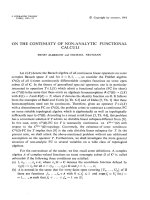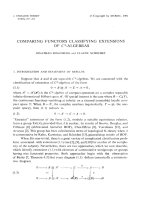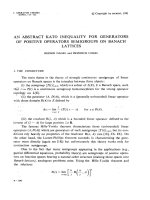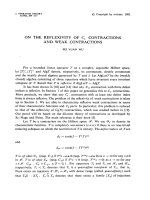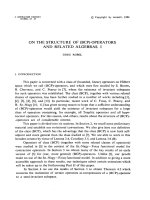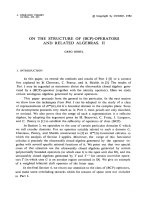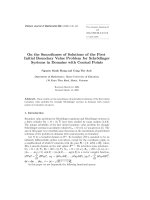Báo cáo toán học: "Computing the period of an Ehrhart quasi-polynomial" ppt
Bạn đang xem bản rút gọn của tài liệu. Xem và tải ngay bản đầy đủ của tài liệu tại đây (121.24 KB, 12 trang )
Computing the period of an Ehrhart quasi-polynomial
Kevin Woods
∗
Department of Mathematics
University of California, Berkeley, USA
Submitted: Jun 9, 2005; Accepted: Jun 24, 2005; Published: Jul 29, 2005
Mathematics Subject Classifications: 05A15, 68W30, 52C07
Abstract
If P ⊂ R
d
is a rational polytope, then i
P
(t):=#(tP ∩ Z
d
) is a quasi-polynomial
in t, called the Ehrhart quasi-polynomial of P .Aperiodofi
P
(t)isD(P ), the
smallest D∈Z
+
such that D·P has integral vertices. Often, D(P ) is the minimum
period of i
P
(t), but, in several interesting examples, the minimum period is smaller.
We prove that, for fixed d, there is a polynomial time algorithm which, given a
rational polytope P ⊂ R
d
and an integer n, decides whether n is a period of i
P
(t).
In particular, there is a polynomial time algorithm to decide whether i
P
(t)isa
polynomial. We conjecture that, for fixed d, there is a polynomial time algorithm
to compute the minimum period of i
P
(t). The tools we use are rational generating
functions.
1 Introduction
Given a rational polytope P ⊂ R
d
(that is, a bounded subset of R
d
which is defined by a
finite collection of integer linear inequalities), define the function
i
P
(t)=#(tP ∩ Z
d
),
where tP is P dilated by a factor of t. Also define D = D(P ) to be the smallest D∈Z
+
such that D·P has integral vertices. Ehrhart proved [Ehr62] that i
P
(t)isaquasi-
polynomial function with a period of D. In other words, there exist polynomial functions
f
0
(t),f
1
(t), ,f
D−1
(t), called the constituents of i
P
(t), such that
i
P
(t)=f
j
(t) for t ≡ j (mod D).
Example 1. P =[0,
1
2
] × [0,
1
2
] ⊂ R
2
.
∗
Partially supported by a Clay Liftoff Fellowship and NSF Grant DMS 0402148.
the electronic journal of combinatorics 12 (2005), #R34 1
Then
i
P
(t)=
t+2
2
2
, for t even
t+1
2
2
, for t odd
.
We know that D is a period of the quasi-polynomial i
P
(t). What is the minimum
period? Certainly, it must divide D. In most cases, in fact, it is exactly D. In certain
interesting examples, however, the minimum period is smaller.
Example 2. Given partitions λ and µ, define the Gelfand-Tsetlin polytope P = P
λµ
⊂
R
N
, as in [DLM04] (following the classic [GC50]), where N is defined in terms of the
lengths of λ and µ.
Then #(P ∩ Z
N
) is the dimension of the weight µ subspace of the irreducible repre-
sentation of GL
n
C with highest weight λ. Though
i
P
(t)=#(P
tλ,tµ
∩ Z
N
)
is a polynomial, that is, it has period one (see [KR86]), D(P ) may be made arbitrarily
large by suitable choice of λ and µ (see [DLM04]).
Example 3. More generally, given partitions λ, µ, and ν such that |λ| + |µ| = |ν|, define
the hive polytope P = P
ν
λµ
⊂ R
N
as in [Buc00] (an exposition of ideas from [KT99]),
where N is defined in terms of the length of λ, µ, and ν.
Then #(P ∩ Z
N
) is the Littlewood-Richardson coefficient c
ν
λµ
, defined to be the multi-
plicity of V
ν
(the highest weight representation of GL
n
(C) corresponding to ν)inV
λ
⊗ V
µ
.
Though
i
P
(t)=#(P
tν
tλ,tµ
∩ Z
N
)
is a polynomial (see [DW02]), D(P ) need not be one.
Example 4. Given any D⊂Z
+
and any s dividing D,letP be the pentagon with
vertices (0, 0), (0, −
1
s
), (D, −
1
s
), (D, 0), and (1,
D−1
D
).
In [MW05], it is shown that this pentagon has D(P )=D, but has minimum period
s.
the electronic journal of combinatorics 12 (2005), #R34 2
These examples raise several questions: When is the minimum period of i
p
(t)lessthan
D(P )? When is i
P
(t) a polynomial? How can we tell what the minimum period of i
P
(t)
is? These questions are wide-open, though [MW05] gives a geometric characterization of
the polygons P ⊂ R
2
such that i
P
(t) is a polynomial. Here, we attack these questions
from a computational perspective. Can we find algorithms to answer these questions
“quickly?”
Letusbemoreprecise. Wedefinetheinput size of an algorithm to be the number
of bits needed to encode the input into binary. In particular, the input size of an integer
a is approximately 1 + log
2
|a| (the number of digits needed to write a in binary). An
algorithm is called polynomial time if the number of steps it takes is bounded by a certain
polynomial in the input size. Proving that an algorithm is polynomial time is generally
regarded as proving that it is “quick,” at least theoretically. See [Pap94] for general
background on algorithms and computation complexity.
Our algorithms will take as input a polytope P . The input size of a polytope defined
by n linear inequalities c
i
,x≤b
i
,wherec
i
∈ Z
d
,b
i
∈ Z, is approximately
nd +
i,j
log
2
|c
ij
| +
i
log
2
|b
i
|.
We can now state the main theorem, which we will prove in Section 4.
Theorem 5. Fix d. There is a polynomial time algorithm which, given a rational polytope
P ⊂ R
d
and an integer n>0, decides whether n is a period of the quasi-polynomial i
P
(t).
In particular, there is a polynomial time algorithm which decides whether i
P
(t) is a
polynomial (that is, whether n =1is a period).
It is important that we fix d in this theorem, because problems of this sort become
intractable if d is allowed to vary. For example, the problem of deciding whether P even
contains an integer point is NP-hard if d is not fixed.
Na¨ıvely applying Theorem 5 yields an algorithm to find the minimum period of i
P
(t)
which, unfortunately, is not polynomial time. We would have to factor D(P ), which would
give us a set of possible n, one of which must be the minimal period. We will prove the
following corollary in Section 4. By a polynomial-time reduction,ofProblemAtoProblem
B, we mean that, if there was some oracle which could solve Problem B instantaneously
(more precisely, in the amount of time it takes to output the answer to Problem B), then
we could use that oracle to get a polynomial time algorithm for Problem A. In other
words, Problem A is “as easy as” Problem B.
Corollary 6. Fix d. There is a polynomial-time reduction of the problem of finding the
minimum period of i
P
(t), where P is a d-dimensional polytope, to the problem of factoring
a natural number D.
the electronic journal of combinatorics 12 (2005), #R34 3
Unfortunately, the problem of factoring is probably hard. It is not known to be
polynomial time (read, not too hard) or NP-hard (read, very hard) and is probably
somewhere in between. Nevertheless, we make the following conjecture.
Conjecture 7. Fix d. There is a polynomial time algorithm, which, given a d-dimensional
polytope P , computes the minimum period of i
P
(t).
The tools we will use are rational generating functions. Given a set S ⊂ Z
d
, define
the generating function
f(S; x)=
a=(a
1
, ,a
d
)∈S
x
a
1
1
x
a
2
2
···x
a
d
d
=
a∈S
x
a
.
Sets that are very large can sometimes be written compactly as rational generating func-
tions in the form
f(S; x)=
i∈I
α
i
x
p
i
(1 − x
b
i1
)(1 − x
b
i2
) ···(1 − x
b
ik
i
)
, (1)
where x ∈ C
d
, α
i
∈ Q, p
i
∈ Z
d
,andb
ij
∈ Z
d
\{0}.
Example 8. S = {0, 1, 2, ,n}, for some n.
Then
f(S; x)=1+x + x
2
+ ···+ x
n
=
1 − x
n+1
1 − x
.
In Section 2, we present several tools to compute and to manipulate rational generating
functions, most of which were proved in either [BP99] or [BW03].
Given a rational polytope P ⊂ R
d
, define the generating function
F
P
(t, z)=f
0
(t)+f
1
(t)z + ···+ f
D−1
(t)z
D−1
,
where the f
i
(t) are the constituents of i
P
(t). In Section 3, we will prove the following
proposition, which will be useful in the proof of Theorem 5.
Proposition 9. Fix d. There is a polynomial time algorithm which, given a rational
polytope P , computes F
P
(t, z) as a rational generating function of the form (1).
Finally, in Section 4, we prove Theorem 5 and Corollary 6.
the electronic journal of combinatorics 12 (2005), #R34 4
2 Rational generating function tools
In this section, we present several tools to compute and manipulate rational generating
functions. Except for Lemma 16, which is proved here, they were proved in either [BP99]
or [BW03].
First we present a tool for creating rational generating functions.
Theorem 10. (Theorem 4.4 of [BP99]) Fix d. Then there exists a polynomial time
algorithm which, for any given rational polyhedron P ⊂ R
d
, computes f(P ∩ Z
d
; x) in the
form
f(P ∩ Z
d
; x)=
i∈I
i
x
p
i
(1 − x
a
i1
)(1 − x
a
i2
) ···(1 − x
a
id
)
,
where
i
∈{−1, +1}, p
i
,a
ij
∈ Z
d
, and a
ij
=0for all i, j. In fact, for each i, a
i1
,a
i2
, ,a
id
is a basis of Z
d
.
Example 11. P is the interval [0,n].
Then P ∩ Z = {0, 1, 2, ,n}, and we have already computed f (P ∩ Z)=
1−x
n+1
1−x
.
Once we have computed some rational generating functions, we also have several tools
to manipulate them.
Let f(x), with x ∈ C
d
, be a rational function in the form (1), and let l
1
,l
2
, ,l
d
∈ Z
n
be integer vectors. These vectors define the monomial map φ : C
n
→ C
d
given by
z =(z
1
,z
2
, ,z
n
) → (z
l
1
, z
l
2
, ,z
l
d
).
If the image of φ does not lie entirely in the poles of f(x), we can define the function
g : C
n
→ C by
g(z)=f
φ(z)
,
which is regular at almost every point in C
n
.Theng(z)isf(x) specialized at x
i
= z
l
i
.In
particular, if l
i
= 0 for all i,theng(z)isf(1, 1, ,1).
Example 12. S is a finite set.
Then f(S;1, 1, ,1) = |S|.
We have the following theorem, which states that, given f(x)asashortrational
generating function, we can find g(z)quickly.
the electronic journal of combinatorics 12 (2005), #R34 5
Theorem 13. (Theorem 2.6 of [BW03]) Let us fix k, an upper bound on the k
i
in (1).
Then there exists a polynomial time algorithm, which, given f(x) in the form (1) and a
monomial map φ : C
n
→ C
d
such that the image of φ does not lie entirely in the poles of
f(x), computes g(z)=f
φ(z)
in the form
g(z)=
i∈I
β
i
z
q
i
(1 − z
b
i1
)(1 − z
b
i2
) ···(1 − z
b
is
)
,
where s ≤ k, β
i
∈ Q, q
i
,b
ij
∈ Z
n
, and b
ij
=0for all i, j.
Now let g
1
(x)andg
2
(x) be Laurent power series given by
g
1
(x)=
m∈
d
α
m
x
m
and g
2
(x)=
m∈
d
β
m
x
m
.
Then the Hadamard product g = g
1
g
2
is defined to be the power series
g(x)=
m∈
d
α
m
β
m
x
m
.
Example 14. S
1
,S
2
are subsets of Z
d
,
g
1
(x)=
m∈S
1
x
m
,andg
2
(x)=
m∈S
2
x
m
.
Then
(g
1
g
2
)(x)=
m∈S
1
∩S
2
x
m
.
More generally, we may take the Hadamard product with respect to a proper subset
of the variables, by defining
g
1
(y, z)
z
g
2
(y, z)=
m∈
d
α
m
(y)β
m
(y)z
m
,
where α
m
and β
m
are functions of y such that
g
1
(y, z)=
m∈
d
α
m
(y)z
m
and g
2
(y, z)=
m∈
d
β
m
(y)z
m
.
We have the following theorem (which is a slightly more general version of Lemma 3.4 of
[BW03], but the proof is the same).
the electronic journal of combinatorics 12 (2005), #R34 6
Theorem 15. Fix k, d
1
, and d
2
.Lety ∈ C
d
1
, z ∈ C
d
2
, and x =(y, z). Then there exists
a polynomial time algorithm which, given l ∈ Z
d
1
+d
2
and functions
g
1
(x)=
i∈I
1
α
i
x
p
i
(1 − x
a
i1
) ···(1 − x
a
ik
)
and
g
2
(x)=
i∈I
2
β
i
x
q
i
(1 − x
b
i1
) ···(1 − x
b
ik
)
such that l, a
i
, l, b
i
=0, computes g = g
1
z
g
2
(where the Laurent power series are
convergent on a neighborhood of (e
l
1
,e
l
2
, ,e
l
d
)).
Note that l in the input of the algorithm is important. For example, if f(x)=
1
1−x
,
then f has two possible Laurent power series expansions
f(x)=1+x + x
2
+ ··· and f(x)=−x
−1
− x
−2
− x
−3
−···
convergent on |x| < 1and|x| > 1, respectively. In this paper, however, the power series
we examine will actually be Laurent polynomials (which are convergent on all of C
d
), so
we will not have to worry about l.
We present one final generating function tool.
Lemma 16. Fix d and k. There is a polynomial time algorithm which, given rational
generating functions g
1
(x) and g
2
(x) in the form (1) which are known to be Laurent
polynomials, decides whether g
1
≡ g
2
.
Remark: The lemma is also true if g
1
(x)andg
2
(x) are Laurent power series with an
infinite number of terms, but there are several complications which will be noted in the
proof.
Proof: Let h(x)=g
1
(x) − g
2
(x). We want to decide whether h ≡ 0. Suppose that
h(x)=
a∈
d
c
a
x
a
,
and let
˜
h(x)=h(x) h(x)=
a∈
d
c
2
a
x
a
.
We can compute
˜
h in polynomial time, using Theorem 15. Then h ≡ 0ifandonlyif
˜
h ≡ 0.
Since we know that h is a polynomial, we must simply check whether
˜
h(1) =
a∈
d
c
2
a
is zero, which we can do in polynomial time using Theorem 13. If we did not know that
h is polynomial, we would have to be a little more careful, and here is a sketch of what
to do. We can find bounds M such that if c
a
= 0 for all a with a
∞
≤ M,thenh is
the electronic journal of combinatorics 12 (2005), #R34 7
identically zero, using, for example, ideas from Section 5.1 of [Woo04]. Then if we take
the Hadamard product
¯
h =
˜
h
x
−M
1
− x
M+1
1
1 − x
1
x
−M
2
− x
M+1
2
1 − x
2
···
x
−M
d
− x
M+1
d
1 − x
d
,
we now have something which is known to be a Laurent polynomial, and h is identically
zero if and only if
¯
h(1) = 0.
3 Computing the generating function
ProofofProposition9: Computing, say, f
0
(t) alone would be easy, by interpolation.
Indeed, first define
g
0
(s)=f
0
(sD).
We may find g
0
(0),g
0
(1), ,g
0
(d) in polynomial time, using Theorems 10 and 13, and
then interpolate, as follows. Let V be the (d +1)× (d + 1) Vandermonde matrix whose
i, j entry is (i − 1)
j−1
as 1 ≤ i, j ≤ d + 1. Then, if g
0
(s)=a
0
+ a
1
s + a
2
s
2
+ ···+ a
d
s
d
,
we have the following equation:
V ·
a
0
.
.
.
a
d
=
g
0
(0)
.
.
.
g
0
(d)
.
Multiplying by the inverse of V ,wegetthecoefficientsofg
0
(s), and can then easily recover
the coefficients of f
0
(t).
We cannot, however, do this for each f
i
(t), sequentially, in polynomial time: there
are D of them, and D may be exponential in the input size. Instead, we perform all D
interpolations simultaneously, using generating functions.
For 0 ≤ i ≤D−1, let
g
i
(s)=f (sD + i) .
For 0 ≤ j ≤ d,let
h
j
(z)=g
0
(j)+g
1
(j)z + g
2
(j)z
2
+ ···+ g
D−1
(j)z
D−1
.
For 0 ≤ i ≤D−1and0≤ k ≤ d,leta
ik
be such that
g
i
(s)=a
i0
+ a
i1
s + a
i2
s
2
+ ···+ a
id
s
d
,
and let
a
k
(z)=a
0k
+ a
1k
z + a
2k
z
2
+ ···+ a
D−1,k
z
D−1
.
the electronic journal of combinatorics 12 (2005), #R34 8
Then we have that
V ·
a
0
(z)
.
.
.
a
d
(z)
=
h
0
(z)
.
.
.
h
d
(z)
.
Therefore, if we can compute each h
j
(z) in polynomial time as short rational generating
functions, then we could compute the a
k
(z) as short rational generating functions by
multiplying by the inverse of V .
We compute
h
j
(z)=g
0
(j)+g
1
(j)z + g
2
(j)z
2
+ ···+ g
D−1
(j)z
D−1
= f
0
(jD)+f
1
(jD +1)z + f
2
(jD +2)+···+ f
D−1
(jD + D−1)z
D−1
= i
P
(jD)+i
P
(jD +1)z + i
P
(jD +2)z
2
+ ···+ i
P
(jD + D−1)z
D−1
,
as follows. Given j, define the polyhedron
Q
j
=
(z, y) ∈ R ⊕ R
d
:0≤ z ≤D−1andy ∈ (jD + z)P
.
Then
f(Q
j
; z, y)=
0≤a≤D−1
z
a
b∈(jD+a)P
y
b
,
and
h
j
(z)=f
Q
j
; z, (1, 1, ,1)
.
We may compute f(Q
j
; z, y) in polynomial time, using Theorem 10, and then perform
the substitution y =(1, 1, ,1), using Theorem 13.
We have shown that we can construct the generating functions a
k
(z), for 1 ≤ k ≤ d,
in polynomial time. We must now use these generating functions to compute
F
P
(t, z)=f
0
(t)+f
1
(t)z + ···+ f
D−1
(t)z
D−1
.
Since, for 0 ≤ j ≤D−1,
g
j
(s)=a
j0
+ a
j1
s + ···+ a
jd
s
d
and
f
j
(t)=g
j
t − j
D
,
we have that
f
j
(t)=a
j0
+ a
j1
t − j
D
+ ···+ a
jd
t − j
D
d
and
F
P
(t, z)=
a
00
+ a
01
t
D
+ ··· + a
0d
t
D
d
+ a
10
z + a
11
t−1
D
z + ··· + a
1d
t−1
D
d
z
.
.
.
.
.
.
.
.
.
+ a
D−1,0
z
D−1
+ a
D−1,1
t−D+1
D
z
D−1
+ ··· + a
D−1,d
t−D+1
D
d
z
D−1
.
the electronic journal of combinatorics 12 (2005), #R34 9
For 0 ≤ k ≤ d, define
b
k
(t, z)=a
0k
t
D
k
+ a
1k
t − 1
D
k
z + ···+ a
D−1,k
t −D+1
D
k
z
D−1
.
Then
F
P
(t, z)=b
0
(t, z)+b
1
(t, z)+···+ b
d
(t, z).
For each k, we will compute b
k
(t, z)from
a
k
(z)=a
0k
+ a
1k
z + a
2k
z
2
+ ···+ a
D−1,k
z
D−1
.
In fact
b
k
(t, z)=a
k
(z)
z
t
D
k
+
t − 1
D
k
z + ···+
t −D+1
D
k
z
D−1
,
and
t
D
k
+
t − 1
D
k
z + ···+
t −D+1
D
k
z
D−1
can be computed as a short rational generating function in polynomial time, by expanding
all of the terms and repeatedly using the fact that, for any k,
∞
i=1
i
k
z
i
is
z
d
dz
k
1
1−z
.
Therefore we can compute the b
k
(t, z) and hence F
P
(t, z) in polynomial time.
4 Deciding whether n is a period
ProofofTheorem5: Given n and P , we want to decide whether n is a period of the
quasi-polynomial i
P
(t). Using Proposition 9, we may compute the generating function
F
P
(t, z)=f
0
(t)+f
1
(t)z + ···+ f
D−1
(t)z
D−1
in polynomial time. Define the generating function
G
n,P
(t, z)= f
n
(t)+f
n+1
(t)z + ···+ f
D−1
(t)z
D−n−1
+ f
0
(t)z
D−n
+ f
1
(t)z
D−n+1
+ ···+ f
n−1
(t)z
D−1
.
Then n is a period of i
P
(t) if and only if F
P
(t, z) ≡ G
n,p
(t, z). We must show how to
compute G
n,P
in polynomial time. Note that
F
P
(t, z)
z
z
n
− z
D
1 − z
= F
P
(t, z)
z
z
n
+ z
n+1
+ ···+ z
D−1
= f
n
(t)z
n
+ f
n+1
(t)z
n+1
+ ···+ f
D−1
(t)z
D−1
the electronic journal of combinatorics 12 (2005), #R34
10
and
F
P
(t, z)
z
1 − z
n
1 − z
= F
P
(t, z)
z
1+z + ···+ z
n−1
= f
0
(t)+f
1
(t)z + ···+ f
n−1
(t)z
n−1
.
Then
G
n,P
(t, z)=
F
P
(t, z)
z
z
n
− z
D
1 − z
z
−n
+
F
P
(t, z)
z
1 − z
n
1 − z
z
D−n
.
This can be computed in polynomial time, using Theorem 15.
We can decide whether F
P
(t, z) ≡ G
n,p
(t, z) using Lemma 16, in polynomial time, and
the proof follows.
Proof of Corollary 6: Compute D = D (P ) by taking the least common multiple of
the denominators of all of the coordinates of the vertices of P . Assume that we can find
the prime factorization of D using an oracle. Initialize the following loop with n
0
:= D.
1. After the jth iteration of the loop, n
j
is known to be a period of i
P
(t).
2. For each prime factor p of n
j
, decide whether
n
j
p
is a period of i
P
(t).
• If none are periods, then n
j
is the minimum period of i
P
(t), and we are done.
• if
n
j
p
is a period of i
P
(t) for some p, then repeat the process with n
j+1
=
n
j
p
.
This loop must terminate, because eventually we would have n
j
=1.
Acknowledgements
Many thanks to Matthias Beck for helpful conversations. These results were originally pre-
sented at the Mathematisches Forschungsinstitut Oberwolfach mini-workshop “Ehrhart-
Quasipolynomials: Algebra, Combinatorics, and Geometry.”
References
[BP99] Alexander Barvinok and James Pommersheim. An algorithmic theory of lattice
points in polyhedra. In New Perspectives in Algebraic Combinatorics (Berke-
ley, CA, 1996–97),volume38ofMath. Sci. Res. Inst. Publ., pages 91–147.
Cambridge Univ. Press, Cambridge, 1999.
the electronic journal of combinatorics 12 (2005), #R34 11
[Buc00] Anders Skovsted Buch. The saturation conjecture (after A. Knutson and T.
Tao). Enseign. Math. (2), 46(1-2):43–60, 2000. With an appendix by William
Fulton.
[BW03] Alexander Barvinok and Kevin Woods. Short rational generating functions for
lattice point problems. J. Amer. Math. Soc., 16(4):957–979 (electronic), 2003.
[DLM04] Jes´us De Loera and Tyrrell McAllister. Vertices of Gelfand-Tsetlin polytopes.
Discrete Comput. Geom., 32(4):459–470, 2004.
[DW02] Harm Derksen and Jerzy Weyman. On the Littlewood-Richardson polynomials.
J. Algebra, 255(2):247–257, 2002.
[Ehr62] Eug`ene Ehrhart. Sur les poly`edres rationnels homoth´etiques `a n dimensions.
C. R. Acad. Sci. Paris, 254:616–618, 1962.
[GC50] Izrail Gelfand and M. L. Cetlin. Finite-dimensional representations of the group
of unimodular matrices. Doklady Akad. Nauk SSSR (N.S.), 71:825–828, 1950.
[KR86] Anatoli Kirillov and Nikolai Reshetikhin. The Bethe ansatz and the com-
binatorics of Young tableaux. Zap. Nauchn. Sem. Leningrad. Otdel. Mat.
Inst. Steklov. (LOMI), 155(Differentsialnaya Geometriya, Gruppy Li i Mekh.
VIII):65–115, 194, 1986.
[KT99] Allen Knutson and Terence Tao. The honeycomb model of GL
n
(C)tensor
products. I. Proof of the saturation conjecture. J. Amer. Math. Soc., 12(4):1055–
1090, 1999.
[MW05] Tyrrell McAllister and Kevin Woods. The minimum period of the Ehrhart quasi-
polynomial of a rational polytope. J. Combin. Theory Ser. A, 109(2):345–352,
2005.
[Pap94] Christos Papadimitriou. Computational Complexity. Addison-Wesley Publish-
ing Company, Reading, MA, 1994.
[Woo04] Kevin Woods. Rational Generating Functions and Lattice Point Sets.PhD
thesis, University of Michigan, 2004.
the electronic journal of combinatorics 12 (2005), #R34 12
